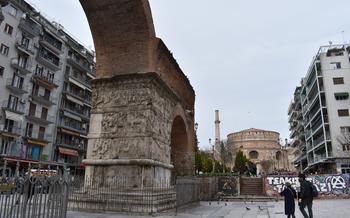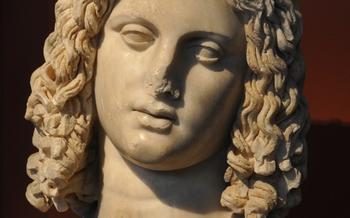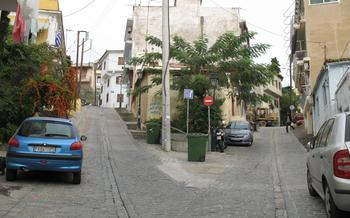
Agios Georgios (Rotonda)
- The Rotunda of Thessaloniki
- A Journey Through Time
- Marvels of Architecture
- A Place of Worship and Reflection
- The Museum of the Rotunda
- Discovering the Rotunda's Surroundings
- A Symbol of Thessaloniki's Past and Present
- The Rotunda's Cultural Events
- The Rotunda in Literature and Art
- The Rotunda's Hidden Corners
- The Rotunda for Families
- The Rotunda at Night
- Accessible Travel at the Rotunda
- Insider Tip: Unveiling the Rotunda's Hidden Gem
The Rotunda of Thessaloniki
In the heart of Thessaloniki, Greece, stands the imposing Rotunda, a magnificent monument that has witnessed the passage of time and the evolution of civilizations. Initially constructed as a Roman temple dedicated to the emperor Galerius in the early 4th century AD, the Rotunda's architectural grandeur and historical significance make it a must-visit attraction for travelers seeking an immersive journey into the city's rich past.
With its impressive cylindrical structure and towering dome, the Rotunda is a testament to the architectural prowess of the Roman Empire. Its walls, adorned with intricate mosaics and frescoes, depict scenes from mythology and imperial life, offering a glimpse into the artistic sensibilities of the era. Over the centuries, the Rotunda has served various purposes, from a Christian church to an Ottoman mosque, before undergoing extensive restoration and being designated as a UNESCO World Heritage Site in 198
Today, the Rotunda stands as a museum, inviting visitors to explore its fascinating history and marvel at its architectural wonders. Its well-preserved interior features a collection of artifacts and exhibits that shed light on the building's diverse past, making it a treasure trove of knowledge for history enthusiasts.
A Journey Through Time
The Rotunda's story begins in the 4th century AD, when it was constructed as a Roman temple dedicated to the emperor Galerius. The temple, part of a larger complex including the Galerius Palace and the Arch of Galerius, was a testament to the power and grandeur of the Roman Empire. The Rotunda's impressive dome, a symbol of Roman engineering prowess, dominated the city's skyline.
Centuries later, as Christianity gained prominence in the region, the Rotunda underwent a transformation. In the 5th century, it was converted into a Christian church, dedicated to Saint George. During this period, the interior of the building was adorned with stunning mosaics and frescoes, depicting scenes from the Bible and the life of Saint George. These intricate artworks, some of which have survived to this day, provide a glimpse into the artistic and religious traditions of the early Christian era.
In the 15th century, Thessaloniki fell under Ottoman rule. During this period, the Rotunda was transformed once again, this time into a mosque. The Ottomans added a minaret to the building and made modifications to the interior to suit their religious needs. Despite these changes, the Rotunda's original architectural features remained largely intact.
In the early 20th century, Thessaloniki was liberated from Ottoman rule and became part of Greece. The Rotunda underwent a thorough restoration, revealing its original grandeur and beauty. In 1988, it was recognized by UNESCO as a World Heritage Site, a testament to its outstanding universal value. Today, the Rotunda stands as a symbol of Thessaloniki's rich and diverse history, a living testament to the city's ability to adapt and evolve over time.
Marvels of Architecture
The Rotunda's architectural grandeur is a testament to the skill and ingenuity of its ancient builders. Its most striking feature is its massive dome, an impressive feat of engineering that has stood the test of time. Constructed using a technique known as "opus caementicium," the dome is made of concrete and brick, and its interior is lined with intricate mosaics depicting various scenes and figures.
The Rotunda's interior walls are adorned with a series of stunning frescoes, many of which date back to the Byzantine period. These frescoes depict religious scenes, biblical figures, and historical events, offering a glimpse into the rich artistic heritage of Thessaloniki. The combination of the dome's mosaics and the wall frescoes creates a visually captivating and awe-inspiring space.
The Rotunda's architectural style is a unique blend of Roman and Byzantine elements. The building's circular shape and the use of concrete are reminiscent of Roman architecture, while the intricate mosaics and frescoes are characteristic of Byzantine art. This fusion of styles reflects Thessaloniki's position as a crossroads of cultures and civilizations throughout history.
Another remarkable feature of the Rotunda is its acoustics. The building's circular shape and domed ceiling create a natural amphitheater, producing exceptional sound quality. This acoustic phenomenon makes the Rotunda an ideal venue for concerts, performances, and other events that require excellent acoustics.
A Place of Worship and Reflection
The Rotunda has served as a Christian church for centuries, playing a significant role in the spiritual life of Thessaloniki. Its impressive architecture and serene atmosphere have made it a popular pilgrimage site for both locals and visitors alike.
Within its walls, visitors can sense the lingering spiritual energy that emanates from centuries of devotion and prayer. The Rotunda's acoustics are particularly noteworthy, creating a reverberant and almost ethereal atmosphere that enhances the experience of worship and contemplation.
Throughout history, the Rotunda has witnessed countless religious ceremonies, baptisms, weddings, and funerals. It has been a place of solace, reflection, and connection with the divine for generations of believers.
Stories and legends abound regarding the Rotunda's spiritual significance. One tale speaks of a young woman who was miraculously healed of a terminal illness after praying fervently within the Rotunda's walls. Another legend tells of a monk who experienced a vision of the Virgin Mary while meditating in the church, leading to the establishment of a nearby monastery.
Whether you are a devout Christian seeking a place of worship or simply a curious traveler interested in exploring the spiritual side of Thessaloniki, the Rotunda offers a unique and awe-inspiring experience that will leave a lasting impression.
The Museum of the Rotunda
The Rotunda houses a fascinating museum that showcases a rich collection of artifacts and exhibits, offering visitors an in-depth exploration of the building's history and significance. Among the highlights of the collection are:
-
Ancient Sculptures: The museum displays an impressive array of ancient sculptures, including marble statues, busts, and reliefs. These works of art provide a glimpse into the artistic traditions and craftsmanship of the Roman and Byzantine periods.
-
Mosaics and Frescoes: The Rotunda's interior is adorned with stunning mosaics and frescoes, which depict biblical scenes, imperial portraits, and decorative motifs. These intricate artworks offer a glimpse into the building's rich artistic heritage and the evolution of Christian iconography.
-
Inscriptions: The museum houses a collection of inscriptions, which provide valuable historical information about the Rotunda and its surroundings. These inscriptions offer insights into the building's construction, its dedication to different deities, and its use as a church and a mosque throughout the centuries.
In addition to these highlights, the museum also features educational programs and activities for visitors of all ages. Guided tours are available, providing a deeper understanding of the Rotunda's history, architecture, and significance. The museum also hosts temporary exhibitions, lectures, and workshops, offering visitors the opportunity to learn more about the Rotunda and its role in Thessaloniki's history.
Discovering the Rotunda's Surroundings
The Rotunda is strategically positioned within the captivating historic center of Thessaloniki. Its immediate surroundings are a treasure trove of ancient landmarks and architectural marvels, each holding a unique story. A short stroll from the Rotunda, you will find the Galerius Palace, an opulent complex that once housed the Roman emperor Galerius. The palace's grand ruins, including the impressive Arch of Galerius, offer a glimpse into the city's glorious past.
To fully immerse yourself in Thessaloniki's rich history, embark on a leisurely walking tour. Begin at the Rotunda, then head towards the Galerius Palace. Along the way, you'll encounter remnants of the city's ancient walls, charming Byzantine churches, and picturesque Ottoman-era buildings. The streets themselves are a testament to Thessaloniki's multicultural heritage, with each corner revealing a new architectural surprise.
For those who prefer a more active exploration, cycling is an excellent way to traverse the city's historic center. Rent a bike and pedal along the scenic waterfront promenade, offering breathtaking views of the Thermaic Gulf. From there, you can easily reach the Rotunda and the surrounding attractions. Remember to bring your camera to capture the many photo opportunities that await you.
A Symbol of Thessaloniki's Past and Present
The Rotunda stands as a testament to Thessaloniki's rich history and serves as a symbol of its enduring spirit. Throughout the centuries, this remarkable building has undergone various transformations, reflecting the city's changing fortunes and cultural influences.
From its origins as a Roman temple to its subsequent adaptation as a Christian church and later a mosque during the Ottoman era, the Rotunda has witnessed and survived countless historical events. Its resilience and adaptability are a testament to the city's ability to embrace change while preserving its heritage.
The Rotunda's enduring significance lies in its role in shaping Thessaloniki's identity. As one of the city's most recognizable landmarks, it has become a symbol of Thessaloniki's cultural diversity and its ability to blend different influences into a unique and vibrant tapestry.
The building's inclusion on the UNESCO World Heritage list further cements its status as a symbol of Thessaloniki's rich cultural heritage, recognized and celebrated on a global scale. The Rotunda stands as a beacon of the city's past, a reminder of its resilience, and a symbol of its vibrant and ever-evolving present.
The Rotunda's Cultural Events
The Rotunda, with its exceptional acoustics and awe-inspiring atmosphere, serves as a captivating venue for a diverse range of cultural events that resonate throughout the city of Thessaloniki. From mesmerizing concerts to captivating exhibitions, this historic landmark transforms into a vibrant stage where art, music, and culture converge.
Throughout the year, the Rotunda plays host to an eclectic array of performances, including classical concerts that reverberate through its hallowed halls, transporting audiences to a realm of timeless melodies. Renowned musicians and orchestras grace the Rotunda's stage, filling the air with enchanting symphonies that resonate with the building's rich history.
In addition to musical performances, the Rotunda also serves as an exceptional backdrop for art exhibitions, showcasing the works of both local and international artists. The building's unique architectural features, combined with the captivating aura of its past, create an immersive environment that enhances the appreciation of artistic creations.
Thessaloniki's vibrant cultural scene finds its expression within the Rotunda's walls, transforming this ancient monument into a dynamic hub of creativity and inspiration. Visitors are invited to immerse themselves in the city's artistic tapestry, attending concerts, exhibitions, and festivals that bring the Rotunda to life in a symphony of cultural experiences.
The Rotunda in Literature and Art
The Rotunda has captured the imaginations of countless artists, writers, and musicians throughout history. In literature, the building is mentioned in the works of renowned Greek poets such as Konstantinos Kavafis and Yannis Ritsos. Kavafis' poem "The Rotunda" explores the building's rich history and its role as a symbol of Thessaloniki's resilience. Ritsos' poem "The City" features the Rotunda as a prominent landmark, representing the city's cultural heritage and its struggles for freedom.
In art, the Rotunda has been depicted in paintings, drawings, and sculptures by both local and international artists. Notable works include the painting "The Rotunda of Thessaloniki" by Greek artist George Bouzianis, which captures the building's grandeur and its unique blend of architectural styles. Another famous depiction is the sculpture "The Rotunda" by French artist Aristide Maillol, which portrays the building as a symbol of strength and endurance.
The Rotunda's unique atmosphere and historical significance have also inspired musicians and composers. Greek composer Mikis Theodorakis composed a piece titled "The Rotunda," which evokes the building's spiritual essence and its connection to the city's past. The building's acoustics and impressive interior have also made it a popular venue for concerts and music performances, further solidifying its status as a cultural icon of Thessaloniki.
The Rotunda's Hidden Corners
Beyond its grand interior, the Rotunda holds secret chambers and hidden corners that reveal its rich history. Descend into the building's crypt, an atmospheric underground chamber that once served as a burial site. Discover the intricate carvings and inscriptions that adorn the crypt's walls, offering a glimpse into the lives of those who were laid to rest here.
Seek out the Rotunda's hidden chambers, tucked away from the main tourist routes. Explore the building's underground tunnels and passageways, uncovering the secrets of its past. Imagine the figures who once traversed these hidden spaces, leaving behind their mark on the building's history.
Uncover the best photo spots within the Rotunda. Capture the building's grandeur from unique angles, revealing its hidden beauty. Immortalize your visit with stunning photographs that showcase the Rotunda's lesser-known features.
Share your own personal stories and experiences of exploring the Rotunda's hidden corners. Describe the thrill of uncovering the building's secrets and the sense of wonder that comes from discovering its hidden treasures.
The Rotunda for Families
The Rotunda offers a unique learning experience for families visiting Thessaloniki. Its historical significance and intriguing stories make it a fascinating destination for children of all ages. Explore the building's hidden corners, such as its crypt and underground chambers, to uncover its secrets and mysteries. Participate in educational programs and workshops designed specifically for families, allowing children to engage with the Rotunda's history and architecture in a fun and interactive way.
To make the most of your family visit, consider booking a guided tour that caters to children's interests. These tours often use storytelling, games, and hands-on activities to bring the Rotunda's history to life. Remember to check out the nearby attractions, such as the Galerius Palace and the Arch of Galerius, which offer additional opportunities for exploration and learning.
When planning your family visit, consider visiting during the summer months when the Rotunda hosts special events and activities for children. These events may include puppet shows, storytelling sessions, and art workshops, providing a fun and educational experience for the entire family.
After exploring the Rotunda, take advantage of the family-friendly restaurants and cafes in the surrounding area. Many of these establishments offer delicious local cuisine and cater to families with children. Enjoy a leisurely meal while discussing your discoveries and creating lasting memories of your time at the Rotunda.
The Rotunda at Night
As the sun sets over Thessaloniki, the Rotunda takes on a new allure. Its illuminated façade, reflecting in the still waters of the Thermaic Gulf, creates a breathtaking spectacle. The building's majestic dome, bathed in a warm golden glow, stands out against the darkening sky, casting a mesmerizing aura over the surrounding area.
For photographers, the Rotunda at night presents a unique opportunity to capture stunning images. The play of light and shadow, the reflections on the water, and the vibrant colors of the surrounding cityscape create a picturesque scene that is sure to leave a lasting impression. Tripods and long exposure times are recommended to capture the full beauty of the Rotunda's nocturnal transformation.
After dark, the Rotunda is not just a sight to behold but also a vibrant hub of activity. The surrounding streets come alive with locals and tourists alike, enjoying the city's nightlife. Numerous restaurants, bars, and cafes in the area offer a delightful culinary experience, often accompanied by live music and entertainment.
Whether you're looking to capture stunning photographs, savor a delicious meal, or simply soak up the vibrant atmosphere, the Rotunda at night is an experience not to be missed. As the city lights twinkle and the stars emerge above, the Rotunda stands as a timeless symbol of Thessaloniki's enduring charm and beauty.
Accessible Travel at the Rotunda
The Rotunda is committed to providing an accessible and enjoyable experience for visitors of all abilities. Wheelchair users and visitors with other mobility impairments can easily access the museum through ramps and elevators. Additionally, audio guides and other assistive technologies are available to enhance the visitor experience.
To ensure a smooth and enjoyable visit, it is recommended to contact the museum in advance to inform them of any specific accessibility needs. The staff is always willing to assist and provide any necessary accommodations.
Remember, everyone deserves to experience the wonders of the Rotunda, regardless of their abilities. By embracing accessibility, the museum creates an inclusive environment where everyone can learn, explore, and appreciate the rich history and cultural significance of this remarkable landmark.
Insider Tip: Unveiling the Rotunda's Hidden Gem
While exploring the Rotunda, take a moment to venture into its lesser-known crypt, located beneath the main floor. Descend the stone steps to discover a hidden chamber that once served as a burial site for early Christian martyrs. The crypt's dimly lit atmosphere and ancient inscriptions create a sense of mystery and reverence. As you wander through the underground passageways, imagine the stories and secrets that these walls could tell. The Rotunda's crypt is a hidden gem that offers a unique glimpse into the building's rich history and spiritual significance.



